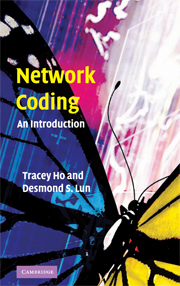Preface
Published online by Cambridge University Press: 06 July 2010
Summary
The basic idea behind network coding is extraordinarily simple. As it is defined in this book, network coding amounts to no more than performing coding operations on the contents of packets — performing arbitrary mappings on the contents of packets rather than the restricted functions of replication and forwarding that are typically allowed in conventional, store–and–forward architectures. But, although simple, network coding has had little place in the history of networking. This is for good reason: in the traditional wireline technologies that have dominated networking history, network coding is not very practical or advantageous.
Today, we see the emergence, not only of new technologies, but also of new services, and, in designing new network protocols for these new technologies and services, we must be careful not to simply transplant old protocols because we are familiar with them. Instead, we must consider whether other, hitherto unused, ideas may lead to better solutions for the new situation.
Network coding shows much promise as such an idea. In particular, various theoretical and empirical studies suggest that significant gains can be obtained by using network coding in multi–hop wireless networks and for serving multi–cast sessions, which are certainly examples of fast–emerging technologies or services. These studies have, for example, encouraged Microsoft to adopt network coding as a core technology of its Avalanche project — a research project that aims to develop a peer–to–peer file distribution system — exploiting the advantages offered by network coding for multicast services.
- Type
- Chapter
- Information
- Network CodingAn Introduction, pp. ix - xiiPublisher: Cambridge University PressPrint publication year: 2008



